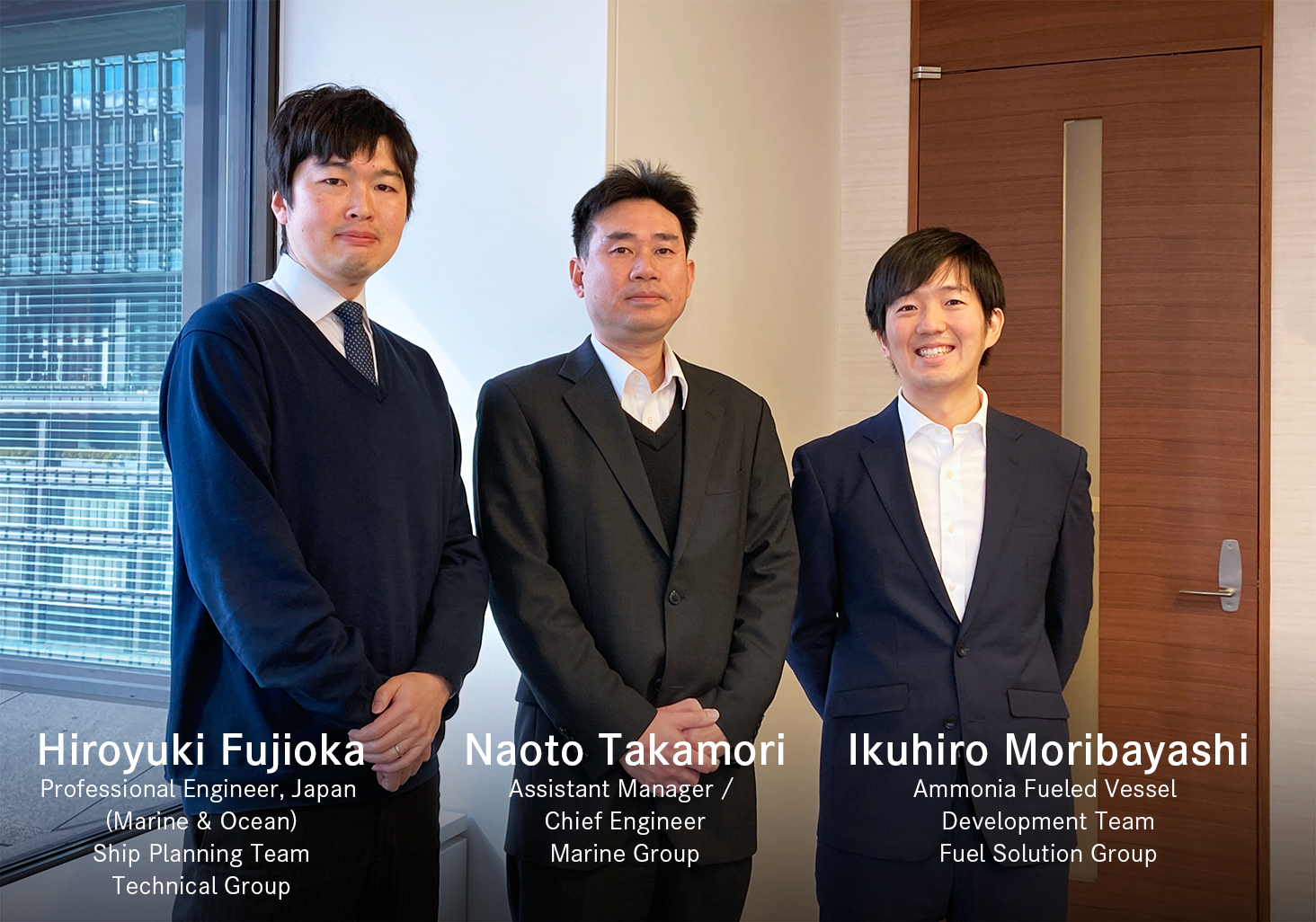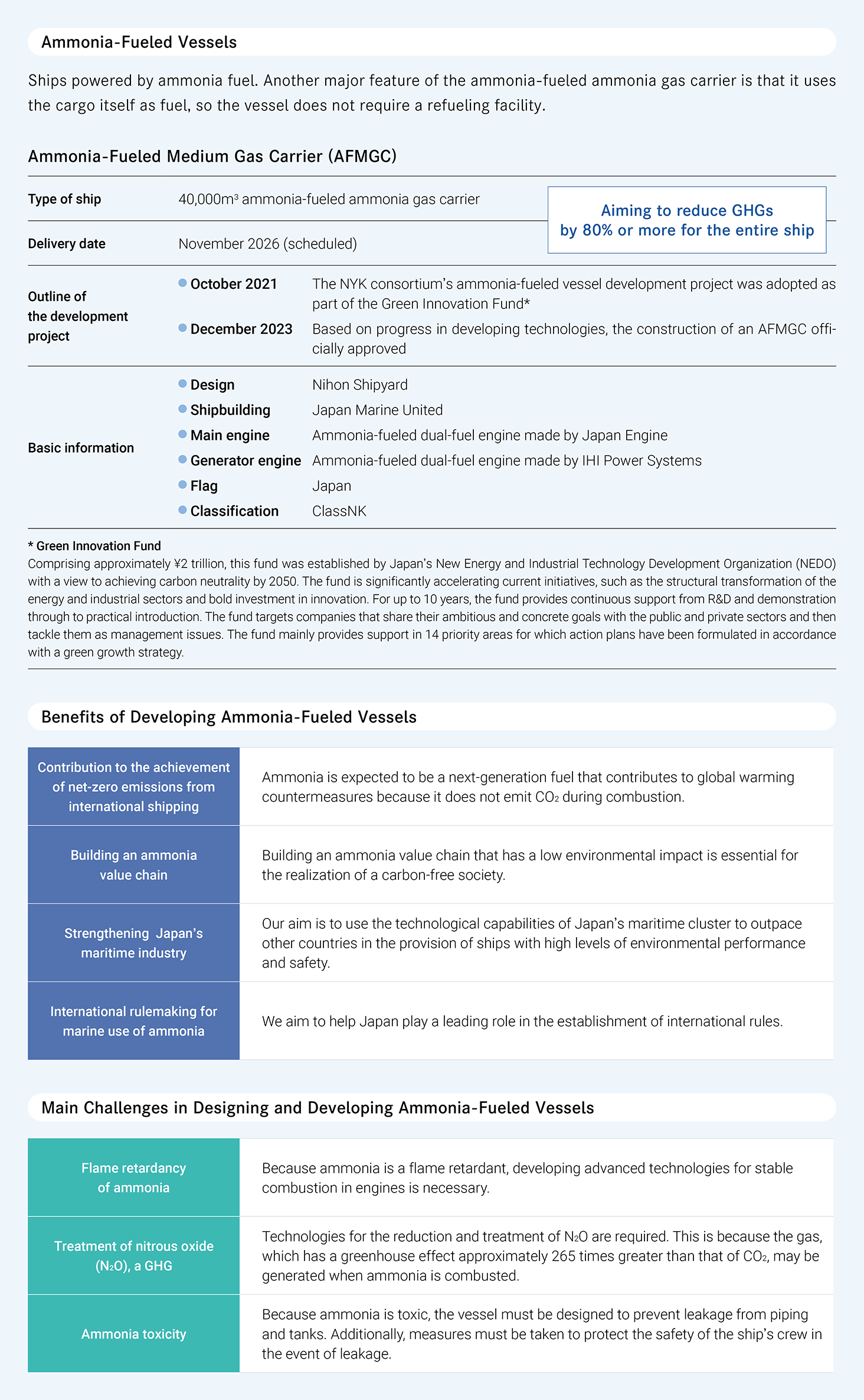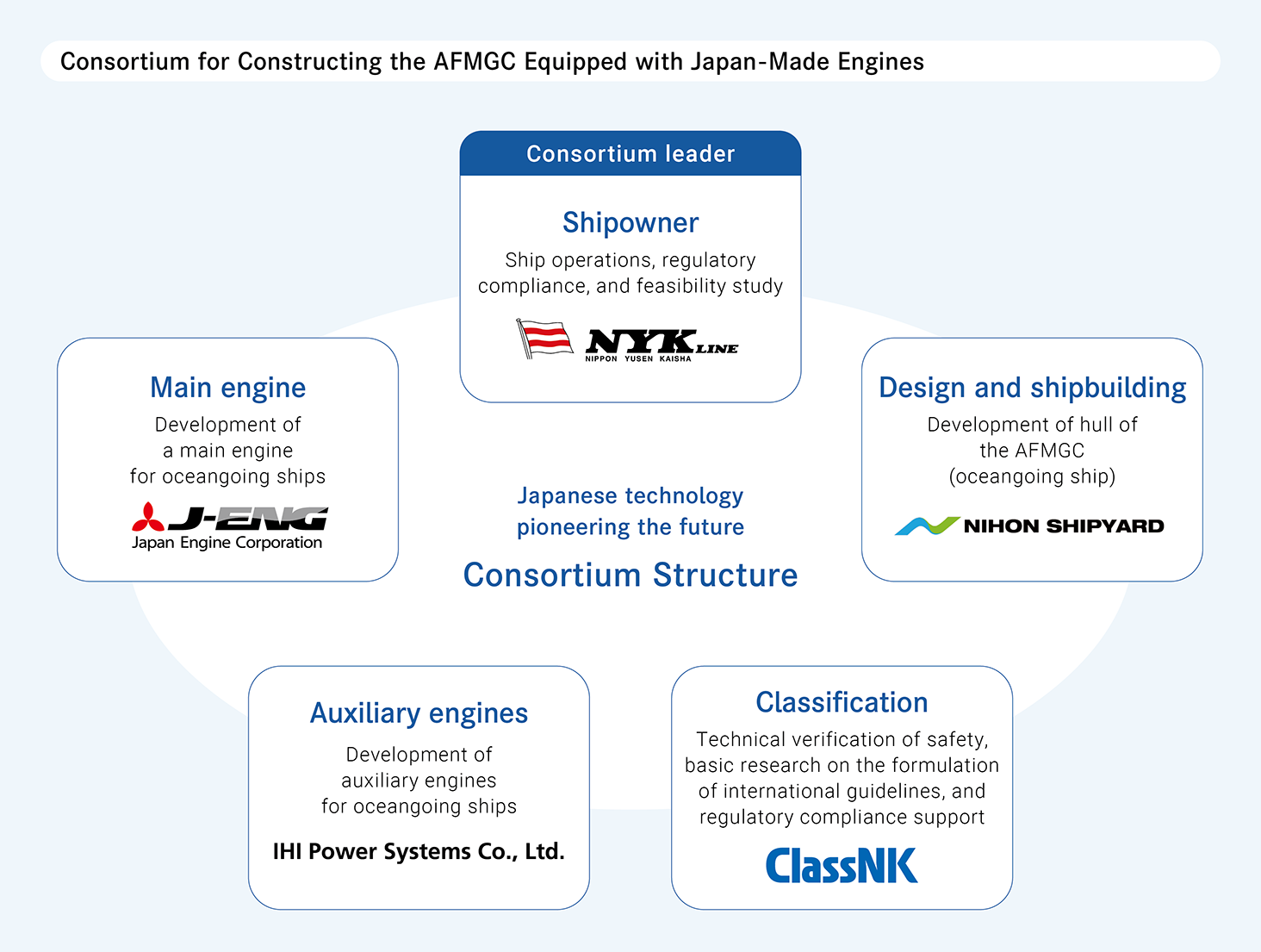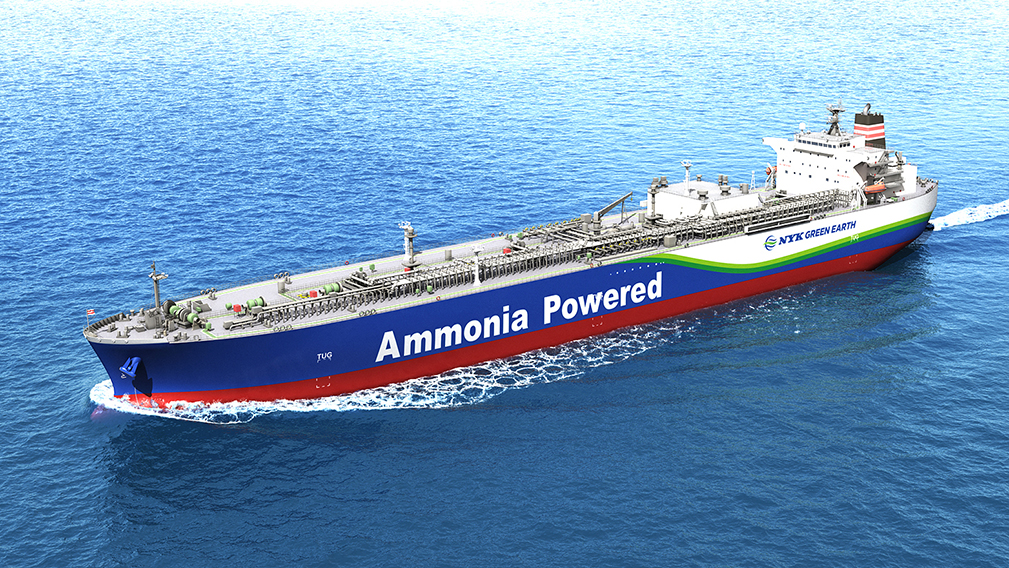Accelerating the NYK Group’s Decarbonization Efforts
As decarbonization gains momentum worldwide, the reduction of GHG (greenhouse gas) is becoming a pressing issue for the maritime industry. The NYK Group has thus set achieving net-zero emissions by 2050 as a long-term target for GHG reduction and is pursuing various initiatives with this goal in mind. One such initiative is our development of the world’s first ammonia-fueled medium gas carrier (AFMGC) equipped with Japan-made engines, a project that is making steady progress.
Heavy oil, the main fuel of ships at present, emits large amounts of CO₂ when used. Alternative fuels are essential to achieve GHG reduction goals. For this reason, ammonia, which does not emit CO₂ during combustion, has been selected as a new fuel that will accelerate decarbonization at once.
When we began the abovementioned project, however, the use of ammonia as a marine fuel was unprecedented worldwide. The construction of ammonia-fueled vessels was also a venture into the unknown.

Taking On the Challenge of Solving Social Issues as a Leader in Maritime Shipping
Ikuhiro Moribayashi, who is in charge of sales and project management, explains why the NYK Group is tackling this project.
“Until recently, I do not think anyone imagined that ammonia could be used as a fuel. However, there is a growing realization that ammonia is one of the most practical options for accelerating the decarbonization of the maritime industry. Since the days of Yataro Iwasaki, rather than only pursuing profits, the Company has focused on benefiting society by solving social issues through businesses. Precisely because we are such a company, we were ahead of competitors in embarking on a project for development of next-generation fuel.”
Moribayashi joined NYK in 2022 as a mid-career hire. Immediately after entering the Company, he was put in charge of the AFMGC development project. Suddenly taking on the task of developing an application in an unknown maritime shipping field sometimes felt daunting for Moribayashi. Nonetheless, he says the predominant feeling was one of elation at being involved in a project of such great social significance.
“Since becoming the person in charge of this project, I have been constantly absorbing specialized knowledge about ships. To be honest, it takes my best efforts to keep up with the project. However, the corporate culture supports me in taking on this and other challenges. Every day is very stimulating. The development and completion of the ship is not the only goal of the project. We are also considering how to make the project a launching pad for the next stage of development, how to strengthen Japan’s maritime cluster, and how to bring benefits to society in general. In addition, we are constantly searching for ways to help formulate fair international rules that maintain safety.”
As well as the practical introduction of next-generation ships, the project is tasked with contributing to society more broadly. One project goal is to strengthen Japan’s maritime industry by establishing an ammonia value chain and developing new technologies. Another goal is to help establish international rules for ships’ use of ammonia. The project reflects an indomitable will to create a business that benefits society and the nation as a whole.

Maintaining an Uncompromising Approach to Safety and Quality
Naoto Takamori has served as an engineer on numerous ships, mainly LNG (liquefied natural gas) carriers. In working on the project, he focuses on the viewpoint of crew members—an essential consideration when ensuring safety. He has a strong sense of his role and responsibilities.
“Ammonia poses a health risk. All possible safety measures must be taken when handling it. As a crew member, I am not without concerns. But ships cannot operate without crew members. We must ensure safety and build next-generation ships that crew members can board with peace of mind. I am here to accomplish this task.”
Ammonia is used as a denitration agent at power plants, as a fertilizer, and as a chemical raw material. When analyzing the safety of ammonia, Takamori visits existing businesses that handle ammonia to conduct interviews about their safety measures. The knowledge gained from these on-site visits is shared within the Company and with development partners to advance R&D on safety measures. He explains the efforts being devoted to safety.
“Any type of ammonia leak during ship operations puts the safety of crew members at risk. To ensure the safety of the AFMGC, more than 40 highly experienced engineers spent a great deal of time reviewing the design drawings and conducting numerous studies.”
Hiroyuki Fujioka, a naval architect responsible for ship design and development, wanted to be involved in R&D on new technologies during his career. However, when he got involved in this project, he realized how difficult the job was.
“Normally, when a shipping company like ours places an order for a ship, we combine equipment that has already been developed and determine the optimal ship specifications. In this project, however, the core engine of the ship and the peripheral equipment associated with the engine will all be newly developed. Ship design partly draws on engineering experience. But, since we didn't have the specifications of a model ship, we had to start from scratch, starting with the placement of equipment. After repeated discussions with the consortium members, the specifications were determined.”
The project is being undertaken by a consortium of five parties, including NYK. In advancing the project, reaching a consensus with outside parties is also necessary. Fujioka’s words reflect the project team’s commitment to safety and quality.
“Building better next-generation ships naturally takes time and money. For this reason, we must carefully manage the budget and delivery deadlines. On the other hand, we cannot afford to lower safety by being overly conscious of deadlines and costs. We must be able to make well-balanced judgments based on evaluations of multiple factors, including not only technical considerations but also safety, delivery deadlines, and costs.”
Tackling the Project through a United Team of Experts
While the development of the ship is proceeding with a view to completion in November 2026, each consortium member has their own way of assessing and approaching the development risks being assumed. Accommodation of these differences was also necessary in proceeding with development.
Moribayashi, who was in charge of coordination, says that he focused on increasing opportunities for dialogue. He describes his unstinting efforts to build relationships among the members of the consortium.
“Everyone is an expert in their particular field and has a different standpoint and way of thinking. So, immediate acceptance of our proposals is rare. I believe that having numerous discussions aimed at understanding the backgrounds that produce these different standpoints and approaches is important. Everyone shares the same passionate desire to build the best ship possible. We are still making strenuous efforts to understand the essence of our partners’ ideas and to find the points where co-creation is feasible.”
Elaborating upon the development process, Moribayashi says that he, Takamori, and Fujioka often attend the same discussions.
“By bringing together other team members’ respective fields of expertise when examining issues that cannot be assessed solely based on one team member’s standpoint, we are able to hold constructive discussions with respective companies.”
Takamori also remarks on the close relationship between the team members.
“In-house departments with advanced levels of specialization often complete projects independently. I have never seen a project in the Company with such a high degree of cross-departmental collaboration. Personnel from both technology and sales departments work together on the project. We take advantage of this mix to have exchanges of opinion that reflect a range of different standpoints. Consequently, the team has a broad perspective and works cohesively.”
The progress of the project is supported by each person’s specialized knowledge and the power created by using this expertise in combination.
Opening the Way to the Future of Japan’s Maritime Industry
In December 2023, NYK, Japan Engine Corporation, IHI Power Systems Co., Ltd., and Nihon Shipyard Co., Ltd., signed a series of contracts to construct the world’s first AFMGC equipped with Japan-made engines. While utilizing know-how garnered from the development of an ammonia-fueled tugboat, which is due for completion in June 2024, the consortium will proceed into a phase of full-fledged shipbuilding with the aim of completion in November 2026.

The completion of the AFMGC will mark a major advancement of the NYK Group’s decarbonization efforts. Fujioka declares his determination to continue moving forward one step at a time with his sights set on the era after the project.
“With this single ship as a start, we must further popularize ammonia-fueled vessels. To this end, we will continue conducting studies and making adjustments aimed at optimizing specifications. At this point, our first task is to concentrate on completing this ship. After that, I will devote myself to the study of specifications and the development of technologies to realize even better ships.”
The utilization of Japanese technology in an ambitious initiative to complete the world’s first AFMGC equipped with Japan-made engines will lead to further development of the maritime industry in Japan. Moribayashi is bullish about the future.
“As the secretariat, we will continue to perform a coordinating role. Ultimately, we would like to show the world that Japan’s maritime cluster can still make great strides.”
In realizing the NYK Group’s mission of “Bringing value to life” through the continual delivery of new value to people, the AFMGC development project will play an important role, with its members continuing to endeavor to ensure that this unprecedented initiative produces concrete results.
(Interview: January 22, 2024)





